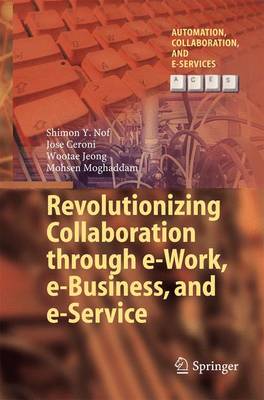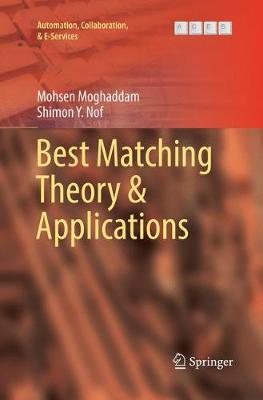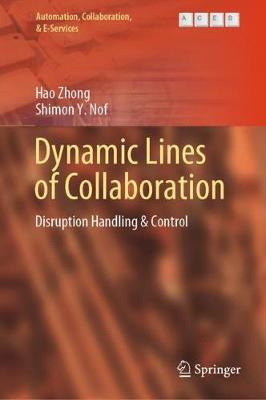Automation, Collaboration, & E-Services
3 primary works
Book 2
Revolutionizing Collaboration through e-Work, e-Business, and e-Service
by Shimon Y. Nof, Jose Ceroni, Wootae Jeong, and Mohsen Moghaddam
Collaboration in highly distributed organizations of people, robots, and autonomous systems is and must be revolutionized by engineering augmentation. The aim is to augment humans' abilities at work and, through this augmentation, improve organizations' abilities to accomplish their missions. This book establishes the theoretical foundations and design principles of collaborative e-Work, e-Business and e-Service, their models and applications, design and implementation techniques. The fundamental premise is that without effective e-Work and e-Services, the potential of emerging activities, such as e-Commerce, virtual manufacturing, tele-robotic medicine, automated construction, smart energy grid, cyber-supported agriculture, and intelligent transportation cannot be fully materialized. Typically, workers and managers of such value networks are frustrated with complex information systems, originally designed and built to simplify and improve performance. Even if the human-computer interface for such systems is well designed, the information and task overloads can be overwhelming. Effective delivery of expected outcomes may not occur. Challenges and emerging solutions in the context of the recently developed CCT, Collaborative Control Theory, are described, with emphasis on issues of computer-supported and communication-enabled integration, coordination and augmented collaboration. Research results and analyses of engineering design methods and complex systems management techniques are explained and illustrated.
Book 3
Mismatch or best match? This book demonstrates that best matching of individual entities to each other is essential to ensure smooth conduct and successful competitiveness in any distributed system, natural and artificial. Interactions must be optimized through best matching in planning and scheduling, enterprise network design, transportation and construction planning, recruitment, problem solving, selective assembly, team formation, sensor network design, and more. Fundamentals of best matching in distributed and collaborative systems are explained by providing:
Methodical analysis of various multidimensional best matching processes
Comprehensive taxonomy, comparing different best matching problems and processes
Systematic identification of systems' hierarchy, nature of interactions, and distribution of decision-making and control functions
Practical formulation of solutions based on a library of best matching algorithms and protocols, ready for direct applications and apps development.
Designed for both academics and practitioners, oriented to systems engineers and applied operations researchers, diverse types of best matching processes are explained in production, manufacturing, business and service, based on a new reference model developed at Purdue University PRISM Center: "The PRISM Taxonomy of Best Matching". The book concludes with major challenges and guidelines for future basic and applied research in the area of best matching.
Book 6
This book focuses on the systematic modeling of complex situations characterized by escalating disruptions, and on cycles of dynamic collaboration for the best handling of disruptions. What can we do about disruptive events and their cascading effects? Thanks to the evolution of intelligent technologies for interaction, communication, sharing, and collaboration, cyberspace is a rapidly expanding world. Our systems of machines, software services, and human organizations have become increasingly interdependent, in other words - networked. As a result, disruptions that initially affect only a small part of any network tend to escalate. At the same time, cyber solutions can support first responders and emergency handlers, enhancing their responsiveness and ability to collaborate with one another in controlling disruptions and preventing their escalation.


